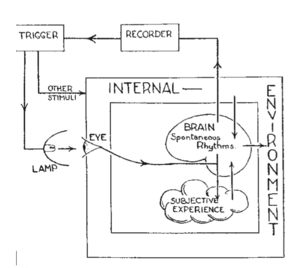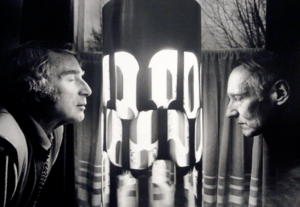User:Stonestone/secondessayfort2stone
Dreamachine -- To Create Space-Out
Introduction
Space-out is a feeling that people can never tell exactly what is by themselves which can be seen as the soul leaving the body. The views that people see in front of them when their minds escape from their bodies, are diverse and different from the others and difficult to tell clearly. However, the trigger points of space-out are quite similar, drugs, alcohol even some specific visuals, for example. Dreamachine, as one of the most critical patent of triggering space-out, also known as a piece of art work, is a good example to explore the phenomenon of space-out. In this essay, I will give my research on how dreamachine make efforts on people and why people get the feeling of space-out.
Flicker
“Flicker” is a long-standing term of art in experimental psychology, referring to visual effects induced by flickering lights. In 1945, Dr. W. Grey Walter applied flicker into his EEG research, in the end an electronic stroboscope was invented. After an experiment in a big range of people, Dr Walt got the feedbacks (strange feelings) from samples he chose, which were:" faintness or swimming in the head"; "unresponsive or unconscious for a few moments"; "the limbs jerked in rhythm with the flashes of light."
As shown in the diagram on the right, eyes receive the lights from the strobes (lamp) as an subjective experienced signal which is transmitted to our brain, then, the signal (brainwave) goes through the recorder make efforts on the trigger.This loop can be seen as the basic prototype of how the visual flicker we look at works on our brain.
" We all noticed a peculiar effect . . . a vivid illusion of moving patterns whenever one closed one’s eyes and allowed the flicker to shine through the eyelids. The illusion . . . takes a variety of forms. Usually it is a sort of pulsating check or mosaic, often in bright colours. At certain frequencies—around 10 per second—some subjects see whirling spirals, whirlpools, explosions, Catherine wheels. " Dr Walter noted after experimented with strobes on himself.
However, those illusions are similar to the hallucinogenic effects of psychoactive drugs such as LSD and mescaline, which is one of the most important reason why it becomes popular in 1960s and led to the invention of dreamachine.
Cybernetics(on going)
As a basic question of cybernetics, how people think Again, cybernetics as brain science appears here as the other side of a performative brain that inhabits spaces of ecstasy and madness as well as the everyday world. 6. If Walter’s list of strange performances and altered states seems odd and wild, it is because the marginalization of many of its entries has been central to the constitution of modernity and the conception of the dualist, freestanding modern self. The East, with its yogis and fakirs, is the other to modern science, the modern self, and the modern West. Dreams and visions are, shall we say, at the edges of modern consciousness.62 This is the nonmodernity of cybernetics, once more. But . . . Second, this research points again to the psychiatric matrix in which Walter’s cybernetics devel- oped. Third, experiments aimed at inducing quasi-epilieptic fits in school- children should only make us grateful for the controls on human-subjects experimentation that have since been introduced.66 Fourth, flicker is a nice exemplification of my notion of a technology of the self, a material technology for the production of altered states. If you want a paradigmatic example of a technology of the nonmodern self, think of flicker. Fifth and finally, Shippy’s feedback circuit deserves some reflection. In the basic flicker setup the brain was pinned down in a linear relation to the technology. The technology did something—flickered—and the brain did something in response—exhibited epileptic symptoms. This counts as a piece of ontological theater inasmuch as it thematizes the performative brain, the brain that acts rather than thinks. But it does not thematize the adaptive brain, the key referent of cybernetics per se: there is no reciprocal back-and-forth between the brain and its envi- ronment.
From Walt to Gysin
Dreamachine
In the post-World War II era, the Beat Generation rediscovered the drug-like strobe machine by reading Dr Walt's book The Living Brain. It starts with an experience of Brion Gysin, a painter, writer, sound poet, and performance artist born in Taplow, Buckinghamshire. In his dairy he wrote:" Had a transcendental storm of colour visions today in the bus going to Marseilles. We ran through a long avenue of trees and I closed my eyes against the setting sun. An overwhelming flood of intensely bright colors exploded behind my eyelids: a multidimensional kaleidoscope whirling out through space. I was swept out of time. I was out in a world of infinite number. The vision stopped abruptly as we left the trees. Was that a vision? What happened to me? "
After reading Dr Walt's book The Living Brain which is lent by William S. Burroughs, Gysin found the answer. That is also the critical point is the relationship establish between Flicker and Dreamachine; Walt and Gysin. Afterwards, Gysin built the Dreamachine in the early 1960's by putting a cylinder with holes onto a record player turntablewith a 100 watt lightbulb in the middle. When the record player being set to spin at 78 round per minute, the strobes turns into the visual of sitting in a bus and passing shades of leaves under the sun, which makes the light flickers at a frequency of about 20 Hz Alpha brainwaves which are associated with subconsciousness.
Space-out
Brainwaves
Visual Speed
Nosebleed - to create space-out
Conclusion
Reference
Nic Sheehan, Flicker, 1997, Documentary, 1:12:02
B.C. ter Meulen D. Tavy B.C. Jacobs, From Stroboscope to Dream Machine: A History of Flicker-Induced Hallucinations, Eur Neurol 2009 pp316–320
Thomas Budzynski, Ph. D., The Clinical Guide to Sound and Light, 2006
David Siever The Application of Audio-Visual Entrainment for the Treatment of Seniors 2004
Luciana Haill ICT & Art Connect : Revelations by Flicker, Dreamachines and Electroencephalographic Signals in Art
http://www.permuted.org.uk/Flickers.htm
http://www.slideshare.net/holcombea/uws-june2013for-slideshare
http://briongysin.com/


